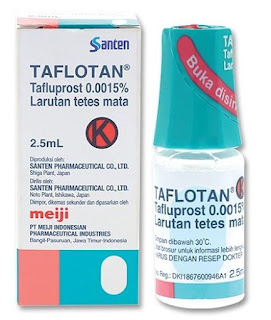Tafluprost 0.0015% is a prostaglandin
analogue which was co-developed by Santen with Asahi Glass Co., Ltd (Tokyo,
Japan) for the treatment of glaucoma and elevated intraocular
pressure (IOP). Unit-dose, preservative- free eyedrops and in combination with
timolol are now also available.
The recommended dose is one drop of tafluprost
in the conjunctival sac of the affected eye(s) once daily in the evening.
PHARMACOLOGY:
Mechanism of action=
Tafluprost acid is a fluorinated prostaglandin
F2α (PGF2α) analogue. Tafluprost is a prodrug of the active substance,
tafluprost acid, a structural and functional analogue of PGF2α. Tafluprost acid
is a selective agonist at the prostaglandin F-receptor, increasing outflow of
aqueous humor via the uveoscleral pathway and thus lowering IOP.
Other PGF2α analogues with the same
mechanism of action include latanoprost and travoprost.
Pharmacokinetics=
Tafluprost is a prodrug ester prostaglandin
F2α-analog designed to expedite the corneal penetration of the drug, which is
then hydrolyzed by corneal esterases to produce the carboxylic acid active
metabolite. The product, tafluprost acid, can then be taken up by the aqueous
humor to therapeutically relevant levels.
Onset of action is 2 to 4 hours after
application, the maximal effect is reached after 12 hours, and ocular pressure
remains lowered for at least 24 hours.
Tafluprost acid is inactivated by beta
oxidation to 1,2-dinortafluprost acid, 1,2,3,4-tetranortafluprost acid, and its
lactone, which are subsequently glucuronidated or hydroxylated. The cytochrome
P450 liver enzymes play no role in the metabolism.
ADVERSE EFFECTS:
The most common side effect of tafluprost
is conjunctival hyperemia, which occurs in 4 to 20% of patients. Less common
side effects include stinging of the eyes, headache, and respiratory
infections. Rare side effects are dyspnea (breathing difficulties), worsening
of asthma, and macular oedema.
Tafluprost causes changes to pigmented
tissues, leading to increased pigmentation of the iris, periorbital tissue
(eyelid) and eyelashes. Before treatment is initiated, patients should be
informed of the possibility of eyelash growth, darkening of the eyelid skin and
increased iris pigmentation. Some of these changes may be permanent, and may
lead to differences in appearance between the eyes when only one eye is
treated.
Usually, the eyelash and pigmentary changes
resolve after discontinuation of the drug.
To reduce the risk of darkening of the
eyelid skin patients should blot off any excess solution from the skin. Nasolacrimal
outflow occlusion or gently closing the eyelid after administration may reduce
the systemic absorption of products administered via the ocular route.
Contact lenses should be removed prior to
the administration of tafluprost, and may be reinserted 15 minutes following
administration.
Caution is recommended in patients with
known risk factors for iritis/uveitis and should generally not be used in
patients with active intraocular inflammation.
Macular edema, including cystoid macular
edema, has been reported during treatment with prostaglandin F2α analogues.
These side-effects usually occur in aphakic patients, pseudophakic patients
with a torn posterior lens capsule or anterior chamber lenses, or in patients
with known risk factors for macular edema. Therefore, caution is recommended
when using tafluprost in these patients.
STUDIES:
In a review performed by Keating, tafluprost
was at least as effective as latanoprost ophthalmic solution 0.005 % in Asian
patients with primary open-angle glaucoma or ocular hypertension. The efficacy
of tafluprost ophthalmic solution 0.0015 % was maintained in the longer term.
[1]
A study by the Tafluprost Multi-center
Study Group and others, found the agent to be effective in lowering IOP in
normal-tension glaucoma (NTG) patients. Mean IOP changes from baseline were
-4.0 +/- 1.7 mmHg in tafluprost administered patients and -1.4 +/- 1.8 mmHg in
Placebo administered patients at 4 weeks, with a statistically significant
difference (p<0.001). [2]
A study by Nakano et al., to evaluate the efficacy
and safety of tafluprost in NTG with IOP of 16 mmHg or less, found the IOP in
the study eyes versus fellow eyes were 10.2 ± 1.6 versus 12.1 ± 1.5 mmHg at
week 12 of treatment. The IOP difference between the study eyes and the fellow
eyes was statistically significant (P < 0.0001, Student's t test). [3]
Hoy has reported good IOP control with the
tafluprost/timolol combination (Taptiqom). [4]
REFERENCES:
- Keating GM. Tafluprost Ophthalmic Solution
0.0015 %: A Review in Glaucoma and Ocular Hypertension. Clin Drug
Investig. 2016 Jun;36(6):499-508. doi: 10.1007/s40261-016-0413-z. PMID:
27225879.
- Kuwayama Y, Komemushi S; Tafluprost Multi-center Study Group. [Intraocular
pressure lowering effect of 0.0015% tafluprost as compared to placebo in
patients with normal tension glaucoma: randomized, double-blind, multicenter,
phase III study]. Nippon Ganka Gakkai Zasshi. 2010 May;114(5):436-43. Japanese.
PMID: 20545217.
- Nakano T, Yoshikawa K, Kimura T, Suzumura
H, Nanno M, Noro T. Efficacy and safety of tafluprost
in normal-tension glaucoma with intraocular pressure of 16 mmHg or less.
Jpn J Ophthalmol. 2011 Nov;55(6):605-13. doi: 10.1007/s10384-011-0082-7. Epub
2011 Aug 27. PMID: 21874307.
- Hoy SM. Tafluprost/Timolol: A Review in
Open-Angle Glaucoma or Ocular Hypertension. Drugs. 2015 Oct;75(15):1807-13.
doi: 10.1007/s40265-015-0476-9. PMID: 26431840.








































